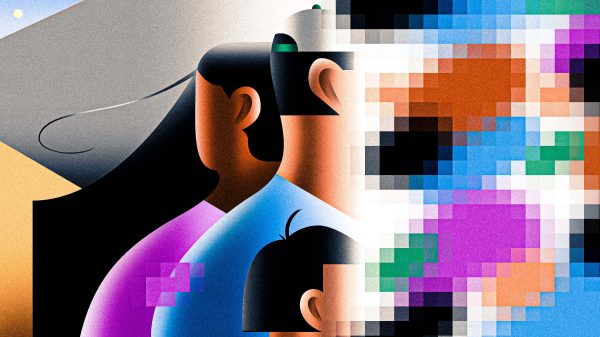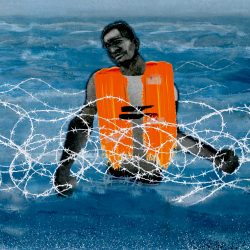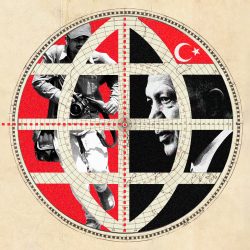
Yevgenia Belorusets
Exploring the everyday lives of the people in eastern Ukraine
The day before Russia launched its full-scale invasion of Ukraine, Yevgenia Belorusets, a Kyiv-based photographer, spoke to me about the people who lived through the Russian-led separtist conflict that began in 2014. The new English translation of her fictional short story collection “Lucky Breaks” is to be published this March and is based on her interviews conducted during her travels in 2015 and 2016 to eastern Ukraine for a documentary photography project.
The eight-year conflict in eastern Ukraine has often been drowned in disinformation and tainted political narratives. Belorusets set out to correct this. I spoke with her about the importance of telling unheard stories, in a conversation that has been edited for length and clarity.
Your book shows what everyday life has been like for eastern Ukrainian factory workers, florists, manicurists, cosmetologists since 2014. Why did you decide that these fragmentary stories had to be told?
In this tragic situation in eastern Ukraine, violence emerges as an unnatural reality imposed from outside. Discussions usually center around big politics and trying to stop the aggressor. And that’s normal. But my work allows me to look at the situation in more detail, to go deeper to the level where the interpersonal is more important than big politics.
I wanted to make this part of reality more visible and reaffirm its right to exist. A right that is very easily overlooked during radical military violence and in international discourse that acts not on behalf of a person, but a continent, country or region.
In one of the stories, “The Stars,” women sheltering in basements decide when it’s safe to go outside based on horoscopes. They don’t know if they are being shelled by Russian-backed militants or the Ukrainian troops and some of them even believe it’s Canada bombing to get the town’s coal. Was the story meant to illustrate the dizzying effect of a constant information war?
In 2014/2015 the Ukrainian media did not know what to do with this catastrophe. The inhabitants of these towns found themselves under attack. And, if before, every single killing of this kind without a trial would have been a crime requiring press and investigation, the new situation was different. People were dying in the streets from shelling, and the media said nothing about these victims, neither Ukrainian nor Russian. Moreover, Russian media began their toxic work of completely distorting the reality, creating numerous contradictory, inconsistent interpretations of events.
The sharp devaluation of one’s own life and these media mirages, media hallucinations, led to all kinds of rumors being spread among the residents of many small towns in Donbas. But most fundamentally, you wished to trust yourself more than any external sources of information. But how do you find your own credibility when there’s fire under your feet? This is what my story is about.

Why are most of the protagonists in stories women?
I didn’t want to bring everything to women’s bodies or women’s voices. But it turned out that the majority of people, whose experience stuck with me or seemed to me important, were women.
Many women were very honest with me exactly because they thought their experience wasn’t as important as that of men and hence so insignificant that talking about it wasn’t even dangerous. The conflict between self-negation and self-expression of those women — these elements seemed very valuable to me while writing.
Yet for me it’s very important to bring this not exclusively to women’s experiences but rather to the experiences that are most often seen among women, the experiences of living through those events as if from the second row of history.
What do people get wrong about how war affects people?
Sometimes, especially in the cities on the frontline, the collateral damage is coming from the Ukrainian side, not only from the Russian side. People live with the constant feeling of danger and incredible unfairness.
Often people from Kyiv go to these places, like international journalists or people trying to help, and they ask these people what they think about politics. Sometimes they say, “We hate the Russians and the Ukrainians, leave us alone.” And these very honest words are often used against them, that they are not patriotic enough, or they’re not pro-Ukrainian enough. Maybe they don’t understand what the political stakes are, but in my view, it’s a very Soviet attitude towards people whose situation is so far from any kind of normalcy that you cannot force them to have some kind of “right” view.
I think these people are heroes because they are trying to go on with their everyday peaceful life in a war zone. And maybe they can show us all how you can remain a person in a conflict, in the situation telling you, “You are not a human now, you can die every day just because you are crossing the street.”
There’s a recurring character in your stories — Andrea. At times she gets very excited about the future but at other times she is very pessimistic about her own life as well as Ukraine’s future, and her presence is always fleeting. What is her role in your book?
The character of Andrea is all about love, about infatuation and connection between two women. She sounds negative and is complaining but complaining is the start of becoming a revolutionary. She is about the relations among different realities in Ukraine, about their capacity to simultaneously hate and love one another. Because in the contexts of such diversity, even mutual dislike can be productive, becoming the part of the exchange, which can be a stage to growth and development.

The story you just read is a small piece of a complex and an ever-changing storyline that Coda covers relentlessly and with singular focus. But we can’t do it without your help. Show your support for journalism that stays on the story by becoming a member today. Coda Story is a 501(c)3 U.S. non-profit. Your contribution to Coda Story is tax deductible.






















